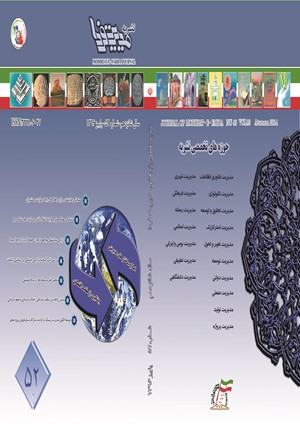اثرات عوامل منابع انسانی سبز بر عملکرد محیطی سازمانهای تولیدی ( مورد مطالعه : شرکتهای پتروشیمی منطقه عسلویه و ماهشهر)
محورهای موضوعی :سهیلا بورقانی فراهانی 1 , بنفشه فتوت 2 , مریم خادم 3
1 - وزارت علوم تحقیقات و فناوری
2 - دانشگاه سمنان
3 - دانشگاه آزاد اسلامی واحد علوم و تحقیقات رشت
کلید واژه: منابع انسانی سبز, عملکرد محیطی, سازمان های تولیدی,
چکیده مقاله :
چکیده پژوهش حاضر با هدف بررسی اثرات عوامل منابع انسانی سبز بر عملکرد محیطی سازمانهای تولیدی در شرکتهای پتروشیمی منطقه عسلویه و ماهشهر صورت گرفت. اين پژوهش از نظر هدف کاربردی و از نوع توصيفي- همبستگي است. جامعه آماری پژوهش شامل کارشناسان و مدیران منابع انسانی در سیستمهای مدیریت محیط زیست و مدیریت ایمنی و بهداشت شرکت های فعال در حوزه پتروشیمی در منطقه عسلویه و ماهشهر به تعداد 600 نفر است که تعداد 234 نفر از آنها به صورت تصادفی عنوان نمونه آماری انتخاب شدند. همچنین جهت جمع آوری داده ها از پرسشنامه های استاندارد عوامل منابع انسانی سبز و عملکرد زیست محیطی انوسینگ و شیخا استفاده شد. در نهایت داده ها ی پژوهش با استفاده از مدل معادلات ساختاری مورد بررسی قرار گرفتند. نتایج نشان داد که ضریب تأثیر تعهد مدیریت ارشد به مدیریت محیط زیست، آموزشهای محیطی کارکنان، کار گروهی کارکنان، مشارکت کارکنان، پاداش زیست محیطی به کارکنان و برنامه های زیست محیطی بر عملکرد سازمان مثبت و معنادار است. اما تأثیر ارتباطات و همکاری های زیست محیطی کارکنان بر عملکرد سازمان معنادار نیست.
Abstract This study aimed to Impact of green human resource factors on environmental performance in manufacturing companies at petrochemical companies in assaluyeh and mahshahr.This is a descriptive-correlational study with applied objective. The target population includes experts and human resource managers health, safety & environment management system of petrochemical companies in assaluyeh and mahshahr. That society is 600 people that the statistical sample consists of234 subjects who were selected by the random sampling method. standard questionnaire of Green Human Resources factors and Environmental performance from Anusingh and Shikha used to collect data Finally the study data was analyzed by Structural Equation Modeling (SEM) method The results showed top management commitment to environmental management, employee environmental training, employees team work, employee Involvement, employee environmental rewards and green programs have a significant and positive impact on environmental performance but environmental cooperation staff had no significant impact on environmental performance.
1. علی احمدی، علیرضا؛ اقبالی، سید محسن؛ بذرپاش، مهرداد. (1395). نقش ویژگی های صنعتی در انتخاب شیوه های مدیریت منابع انسانی و تقویت سرمایه اجتماعی سازمانی در کشور ایران. نشریه مدیریت فردا، سال پانزدهم. 5-17#
2. Anusingh. L., and Shikha. G. (2015). Impact of green human resource factors on environmental performance in manufacturing companies: empirical evidence. International journal of engineering and management science. I.J.E.M.S., VOL.6 (1) 2015: 23-30.#
3. Chen, T. B., & Chai, L. T. (2010). Attitude towards the environment and green products: consumers' perspective. Management science and engineering, 4(2), 27.#
4. Daily, B. F., & Huang, S. C. (2001). Achieving sustainability through attention to human resource factors in environmental management. International Journal of Operations & Production Management, 21(12), 1539-1552#.
5. Dota, A. (2012). Water footprint–a new approach in water resources management. application in the prefecture of karditsa Jabbour, C. J. C. (2013). Environmental training in organisations: From a literature review to a framework for future research. Resources, Conservation and Recycling, 74, 144-155#.
6. Margaretha, M., & Saragih, S. (2013, March). Developing new corporate culture through green human resource practice. In International Conference on Business, Economics, and Accounting (pp. 1-10)#.
7. Renwick, D. W., Redman, T., & Maguire, S. (2013). Green human resource management: A review and research agenda. International Journal of Management Reviews, 15(1), 1-14.#
8. Renwick, D., Redman, T., & Maguire, S. (2008). Green HRM: A review, process model, and research agenda. University of Sheffield Management School Discussion Paper, (2008.01).#
9. Sarumpaet Susi , (2005) , " The Relationship between Environmental Performance and Financial Performance Amongst Indonesian Companies" Jurnal Akuntansi & Keuangan ,vol. 7,no. 2, pp 89- 98#
10. Sathyapriya, J., Kanimozhi, R., & Adhilakshmi, V. (2013). Green HRM-Delivering high performance HR systems. International Journal of Marketing and Human Resource Management, 4(2), 19-25.#
11. Storey, J. (2001). Human resource management today: an assessment. Human Resource Management: A Critical Text, 2nd ed. London: Thompson Learning, 3-20#
12. Uusi-Rauva, C., & Nurkka, J. (2010). Effective internal environment-related communication: An employee perspective. Corporate Communications: An International Journal, 15(3), 299-314.#
13. Wagner, M. (2013). ‘Green’human resource benefits: do they matter as determinants of environmental management system implementation?. Journal of Business Ethics, 114(3), 443-456.#
14. Watt, D. J., Kayis, B., & Willey, K. (2009). Identifying key factors in the evaluation of tenders for projects and services. International Journal of Project Management, 27(3), 250-260.#
15. Zutshi, A., & Sohal, A. (2004). Environmental management system adoption by Australasian organisations: part 1: reasons, benefits and impediments. Technovation, 24(4), 335-357.#
16. Zhu, Q., Sarkis, J., & Lai, K. H. (2008). Confirmation of a measurement model for green supply chain management practices implementation. International Journal of Production Economics, 111(2), 261-273#
17. Zeithaml, V. A., Berry, L. L., & Parasuraman, A. (1996). The behavioral consequences of service quality. the Journal of Marketing, 31-46.


